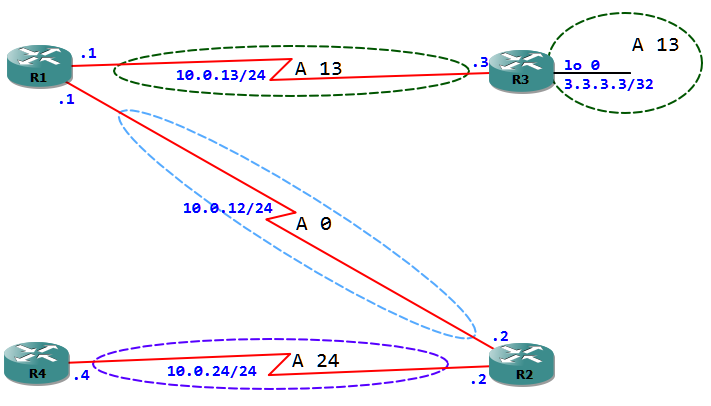OSPF LSAs could be filtered from the originating router to a specified neighbor. We have the following options
- Using prefix suppression
- Using database filter
OSPF LSAs could be filtered from the originating router to a specified neighbor. We have the following options
As all routers in an area must have the same copy of the database and each route builds its RIB by running SPF algorithm , Intra area routes can only be filtered locally on a router.

Type 1 LSA Filtering can be done in 2 different ways:
Case 1: The loopback networks of R1 must be filtered from entering the RIB of R2. The 10.0.13.0/24 network must be reachable via R1 and R3.
As link state protocols do not exchange routes, Selective route filtering can be done only on an ABR.
Type 3 LSA filtering can be achieved in 2 different ways. This can be done by using:
NAT Inside: The Source Address of the Packet is translated as the Packet hits the INSIDE interface, if the NAT Router finds that the destination IP is not directly attached and it has a ROUTE to the destination.
The DA of the Packet changes as a Packet hits the OUTSIDE interface. Then it gets ROUTED.
NAT Outside: The Destination Address of the Packet changes as the Packet hits the INSIDE interface. Then it gets ROUTED to the destination. When the Packet hits the OUTSIDE interface, it is ROUTED first then the Source Address of the Packet changes.
A distance Vector protocol only exchanges remote routes, if it learns the route from the same protocol. It means that it looks at the RIB for the remote routes learned and then it sends an update regarding this to other routers.
OSPF has the same characteristics when doing inter area routing. The main reason for an Autonomous System division into logical areas is to reduce the size of the LSDB . This implies that a router in the non-backbone will not have the complete view of the topology as the backbone area routers. They only have the information told to them from the ABR.
The ABR generates a Type 3 summary LSA, only if it has a corresponding Type 1 LSA or an Inter-area route in its RIB. If it does not have any of them, the Type 3 LSA will not be generated or regenerated.

In the above topology R4 will have an inter area route to the loopback of R3. This O IA route exists at R4 because R2, which is an ABR has a respective route via OSPF to the loopback of R3. This also means that R4 will lose the Type 3 LSA to the 3.3.3.3/32 network, if R2 does not have it in its RIB as an OSPF learned route.
Let us check this case. We can apply a static route to 3.3.3.3/32 on R2, which will then remove the OSPF route from its RIB. Thus it will be incapable to regenerate the Type 3 LSA which it learned from R1.
OSPF: Detect change in LSA type 3, LSID 3.3.3.3, from 22.22.22.22 area 24
OSPF: Schedule partial SPF - type 3 id 3.3.3.3 adv rtr 22.22.22.22
OSPF: Service partial SPF 1/0/0
OSPF: process partial spfQ entry
OSPF: process partial spfQ LSA id 3.3.3.3: mask 255.255.255.255, type 3 adv_rtr 22.22.22.22, age 3600, seq 0x80000005 (Area 24)
OSPF: process summary partial ABR 0x0 txit 0x0 LSA 3.3.3.3: mask 255.255.255.255, t3 adv 22.22.22.22, age 3600, seq 0x80000005 (Area 24)
OSPF: Start partial processing Summary LSA 3.3.3.3, mask 255.255.255.255, adv 22.22.22.22, age 3600, seq 0x80000005 (Area 24) type 3
OSPF: inter-route to 3.3.3.3/32 became unreachable, check externals
The ‘debug ip opsf spf’ output shows that R2 (RID 22.22.22.22) sends a max age LSA for the network 3.3.3.3/32. This causes R4 to remove the Type 3 LSA .
R2 did not regenerate the Type 3 LSA because it does not have an O IA route installed in its RIB. But the case would be different with R1. Let us again install a static route at R1 for the loopback of R3. R1 will still generate a Type 3 LSA because it has a Type 1 LSA for the 3.3.3.3/32 network.
R1#sh ip route static
3.0.0.0/32 is subnetted, 1 subnets
S 3.3.3.3 [1/0] via 10.0.13.3
R1#sh ip ospf database self-originate
OSPF Router with ID (11.11.11.11) (Process ID 1)
Router Link States (Area 0)
Link ID ADV Router Age Seq# Checksum Link count
11.11.11.11 11.11.11.11 652 0x80000007 0x00B906 2
Summary Net Link States (Area 0)
Link ID ADV Router Age Seq# Checksum
3.3.3.3 11.11.11.11 652 0x80000006 0x003688
10.0.13.0 11.11.11.11 652 0x80000006 0x00A410
Router Link States (Area 13)
Link ID ADV Router Age Seq# Checksum Link count
11.11.11.11 11.11.11.11 652 0x80000007 0x00533E 2
Summary Net Link States (Area 13)
Link ID ADV Router Age Seq# Checksum
10.0.12.0 11.11.11.11 652 0x80000006 0x00AF06
10.0.24.0 11.11.11.11 652 0x80000006 0x00ADBB
To conclude, an ABR will only generate a Type 3 LSA when it has a corresponding Type 1 LSA. An ABR will regenerate a Type 3 LSA only if it has a corresponding Inter area route.